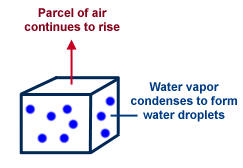|
|
. |
Rising Air
a key process in the production of clouds and precipitation
Imagine a block of air, or air parcel, rising upward through the atmosphere.
The air parcel expands as it rises and this expansion, or work, causes
the temperature of the air parcel to decrease.
 |
As the parcel rises, its humidity
increases until it reaches 100%.
When this occurs, cloud droplets begin forming as the
excess water vapor condenses
on the largest aerosol particles. Above this
point the cloud droplets grow by
condensation in the rising air.
|
If the cloud is sufficiently deep or long lived,
precipitation will develop.
 |
The upward motions that generate clouds and lead to precipitation can be
produced by convection in unstable air,
convergence of air near cloud base,
lifting of air by fronts and
lifting over elevated topography such
as mountains. |

relative humidity
|
|

convection
|
|



